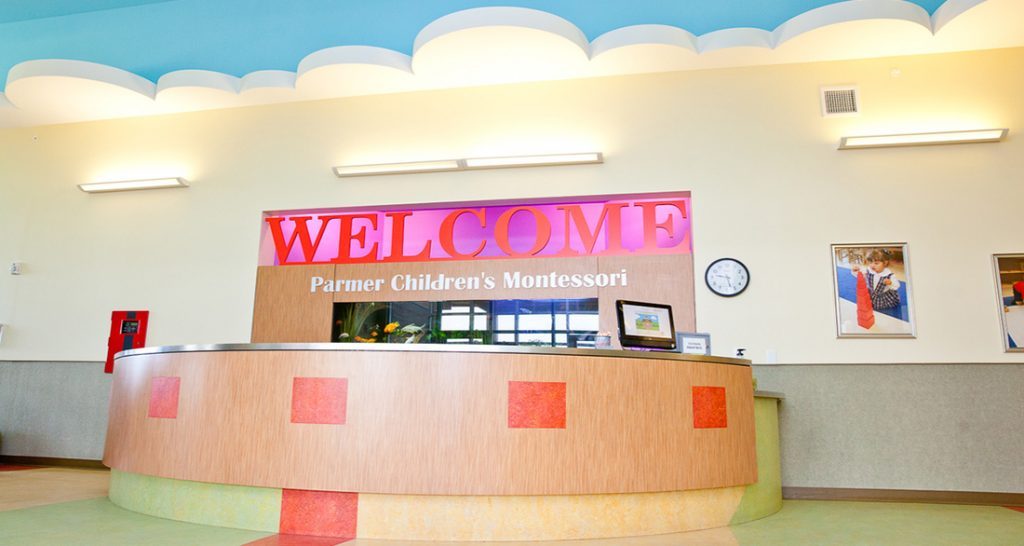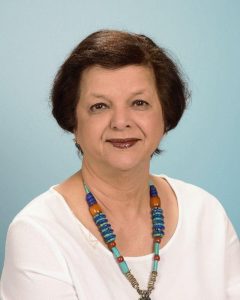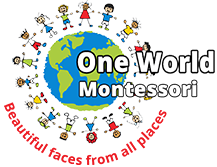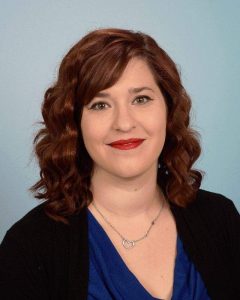OUR MISSION STATEMENT
Our mission is to provide a complete Montessori education that will help nurture and develop “the whole child” emotionally, intellectually, socially, creatively and physically by addressing the uniqueness of each child.
- We believe:
- A spirit of cooperation rather than competition is the most conductive environment for learning.
- Success builds confidence.
Children learn best in an environment of love, security, understanding and consistency. - Children should be respected and taught to respected others and the materials around them.
- Learning should be a happy and joyous experience!
- Teachers should encourage children to do their best and not the minimum. They will also encourage a strong and positive self-image to each and every child.
- The child’s spirit in all aspects is our first priority.
ABOUT OWM
Our goal at One World Montessori is to give a great education and proper nurturing to our children. We offer a modified Montessori Method of education for children ages 18 months – 6 years. We work with the child to achieve great standards of skills through hands-on learning. We offer an enlightening and nurturing prepared Montessori environment to educate and support each individual child in building a foundation for life-long learning. We have also developed a milestone based infant program. Our infant curriculum was developed to help children 6 weeks – 18 months stay on track and hit each and every developmental milestone while lovingly developing the child’s spirit.
OUR CAMPUS

*Our school has several age appropriate playgrounds. Gardens*
One World Montessori has a beautiful campus located in both North Austin and Round Rock. Our schools attracts a diverse student body representing many ethnic backgrounds, religions, and cultures. All of these diversities are enthusiastically celebrated. The curriculum is used to promote global understanding and peace.
OUR CURRICULUM
Our school follows the Montessori Method. Dr. Maria Montessori realized that a young child had great potential for learning. To challenge a young mind she developed an alternative method of teaching that emphasized specially trained teachers and uniquely designed learning materials and apparatuses.
A Montessori classroom environment is prepared and structured to allow a child to learn through exploring independently at their own pace. This helps to create a stronger desire to learn that will stay with them through life.
The practical life exercises are the most important and beginning point in a Montessori environment. These are activities that provide real life experiences for the child. The exercises are designed to foster independence, self-confidence, self-esteem, and self control characteristics that play a critical role in subsequent intellectual growth. They support the “whole child” development-physical, mental and moral.
- To grow in self-knowledge
- To grow in independence
- To develop motor perception and perfect movement.
- To appreciate his/her culture
- To develop a sense of responsibility
- To develop power of concentration
- Small/large motor activities
- Care of the environment
- Selfcare of planets and animals
- Grace and Courtesy
- DEVELOPMENT OF THE SENSES
- DEVELOPMENT OF VERBAL LANGUAGE
- PREPARATION FOR WRITING
- PRE-READING ACTIVITIES READING (PHONETIC)
- SPELLING
- ADVANCED READING
- JOURNALS
- NUMBERS TO 10
- DECIMAL SYSTEM
- TEENS AND TENS
- LINEAR COUNTING
- ADDITION
- SUBTRACTION
- FRACTIONS
- To help the child get to know the world.
- To make order in the animal kingdom.
- To learn about natural environment.
- GEORGRAPHY (GLOBE AND MAPS)
- HISTORY (TIME)
- SCIENCE (ANIMAL/PLANT)
- ART
- MUSIC *Creative arts, music and movement is also encouraged to express their creativity, explore their imagination, and encourage self-expression.
Outside Play
Movement in Circle
*Soccer Shots
*Dance Connection
OUR DAILY ROUTINE
Breakfast- OWM has an on-site chef that proved breakfast for the children from 8:30am-9:00am. Infants/Toddlers sit down together as a group for breakfast. Primary Classrooms provide a self serve station where children are encouraged to eat breakfast.
Work Time- The children start the day by independently choosing activities from different areas of the classroom. Here the children work independently or receive an individual or small group lesson from the Lead Teacher.
Circle Time- During this time the children learn to interact and participate as part of a community. Through music, movement, stories, show and tell, group lessons, the children build concentration, self-control, and positive social skills.
Lunch – OWM has an on-site chef that provides a healthy fresh lunch for children. Children in our Infant A , B and C classrooms have boiled or steamed vegetables and everything is cut to an appropriate size for the children to eat.
Outside Play- OWM provides age appropriate playgrounds for the children. The playground equipment is designed for gross motor development and social skills.
Nap Time- The children in our Infant A and B program nap on an on demand schedule set up by the parents every month throughout the day. The children in our Toddler Program nap after their lunch. In our Primary program an additional hour of advanced academics then lay down to rest in their classrooms for an hour.
Afternoon Snack – OWM provides snacks for children in our Infant B, C, Toddler and Primary Program. Toddlers sit down together as a group for snacks. Primary classrooms provide a self-serve station where children are encouraged to eat snack.
OUR STAFF
We believe teachers are the backbone of our educational facility. We pride ourselves on hiring the very best teachers to ensure each child receives the highest quality care and education. To ensure the safest learning environment all staff members are required to have current CPR/ First Aid Certification, Pre-Service Training as well as undergo FBI Criminal Background Checks. One World Montessori School selects the highest quality educators to lead the children in their learning adventures. Our “Lead Teachers” have undergone intense training and course study to become “Montessori Certified”. These professionals have spent years learning how to provide individual lessons, structure the classroom environment for optimal learning, gained a true understand of child development, and above all have a respect for children and families.
The Montessori Teacher is a guide rather than the center of attention. The teacher works with each child on an individual basis, monitoring his progress and presenting new lessons when he is ready for a new lesson. The materials presented are sequenced and often self-correcting so the child can learn without constant teacher intervention. The teachers follow three Montessori principles which are observation, individual liberty and prepared environment.

Jodi Someshwar is a management graduate from University of Texas at Dallas. She has held responsible positions at Texas Instruments, Digital Equipment Corporation, Radiant Corporation and the Texas Rehabilitation Commission. Her undergraduate education is in child Psychology and she worked with children at the University of Texas, Austin in 1974. She became interested in Montessori child development curriculum after seeing her grandchildren go to local child care centers. She became associated with Preston Park Montessori and Preston Creek Montessori in Plano Texas. After reviewing their program and spending some time with them, Jodi decided to start a Montessori school here in Austin with the help of associates in Plano and in Austin. Her goal is to create a ‘first in class’ child development center using Montessori methods. She is a candidate for the Montessori Primary Diploma from Collins College this July 2014.
ABOUT MONTESSORI
The Montessori Method of Education, developed by Maria Montessori, is a child-centered educational approach based on scientific observations of children. Montessori’s method has been used for over 100 years in many parts of the world.
The Montessori Method views the child as the one who is naturally eager for knowledge and capable of initiating learning in a supportive, thoughtfully prepared learning environment. It attempts to develop children physically, socially, emotionally and cognitively.
Although a range of practices exist under the name “Montessori”, the Association Montessori International (AMI) and the American Montessori Society (AMS) cite these elements as essential:
- Mixed age classrooms
- Student choice of activity from within a prescribed range of options.
- Uninterrupted blocks of work time.
- A constructivist or “discovery” model, where students learn concepts from working with materials, rather than by direct instruction.
- Specialized educational materials developed by Montessori and her collaborators often made out of natural, aesthetic materials such as wood, rather than plastic.
- A thoughtfully prepared environment where materials are organized by subject area, within reach of the child, and are appropriate in size.
- Freedom within limits.
- A trained Montessori teacher who follows the child and is highly experienced in observing the individual child’s characteristics, tendencies, innate talents and abilities.
The Montessori Theory is an approach to learning developed by Maria Montessori where the key principles are independence, observation, following the child, correcting the child, prepared environment and absorbent mind. The Montessori Theory approach, concepts and foundation principles can be applied across all ages.
- Preparing the most natural and life supporting environment for the child.
- Observing the child living freely in this environment.
- Continually adapting the environment in order that the child may fulfill their greatest potential – physically, mentally, emotionally and spiritually.
A Montessori curriculum focuses on key developmental milestones in children between the ages of three and five-years-old. Younger children focus on honing large muscle and language skills. Four-year-olds work on fine motor skills and completing everyday activities, such as cooking and arts and crafts. Older preschoolers broaden their learning experience to their communities, through trips and special events.
2. Encourages Cooperative Play
Because the teacher does not “run” the classroom, students guide the activities they do throughout the day. This encourages children to share and work cooperatively to explore the various stations in the Montessori classroom. Children in Montessori classrooms, by the very nature of the environment, learn to respect one another and build a sense of community.
3. Learning Is Child-Centered
Montessori preschool students enjoy a classroom and curriculum designed around their specific needs and abilities that allows them to explore and learn at their own pace and on their own terms. Everything in the classroom is within reach of the child, and furniture is sized for children to sit comfortably. In addition, older children in the class work with the younger ones, so mentoring comes as much from peers as it does from the adult teachers in the classroom.
4. Children Naturally Learn Self-Discipline
While the Montessori Method allows children to choose the activities they want to work on each day, and how long they will work at a specific task, there are specific “ground rules” for the class that are consistently enforced by the teacher and other students. This environment naturally teaches children self-discipline, and it refines important skills like concentration, self-control and motivation.
5. Classroom Environment Teaches Order
All objects and activities have precise locations on the shelves of a Montessori classroom. When children are finished with an activity, they place items back into their appropriate places. This sense of order helps facilitate the learning process, teaches self-discipline, and caters to a young child’s innate need for an orderly environment. When children work and play in an area that is neat and predictable, they can unleash their creativity and focus fully on the learning process.
6. Teachers Facilitate the Learning Experience
Teachers in the Montessori classroom are “guides” that are there to facilitate the learning experience, rather than determine what it will look like. Teachers take the lead from the children in the classroom, ensure the ground rules are followed, and encourage students to perform tasks at their own pace. However, teachers do not determine the pace of the classroom – that is strictly up to individual students, as teachers strive to remain as unobtrusive as possible.
7. Learning Method Inspires Creativity
Since children are allowed to choose their activities and work at them on their own terms, creativity in the classroom is encouraged. Children work at tasks for the joy of the work, rather than the end result, which allows them to focus more on process than result – a natural path to creativity. Exposure to a wide variety of cultures also encourages children to broaden their thinking about the world and address those concepts in a variety of ways.
8. May be More Effective in Developing Certain Skills
Research conducted by Dr. Angeline Lillard, a professor of psychology from the University of Virginia at Charlottesville, examined the abilities of children who have been taught in a Montessori school. Published in 2006 in the journal Science, the research studied Montessori students in Wisconsin and found that five-year-olds in Montessori classrooms had higher math and reading skills than their counterparts in public schools. In addition, the study compared 12-year-old Montessori and non-Montessori students. While math and reading skills appeared to be more on par with this age group, social development appeared to be higher in Montessori students by this age.
9. System is Highly Individualized to Each Student
Students in the Montessori program are allowed to explore activit>ies and concepts at their own pace. This naturally encourages children to try more challenging areas, which accelerates their learning experience. Learning occurs at a comfortable pace for each student, rather than inflicting the same rate on every student in a classroom.
10. Curriculum Focused on Hands-On Learning
One of the greatest benefits of the Montessori Method, particularly during the early learning experience, is the focus on hands-on learning. The emphasis is on concrete, rather than abstract learning, as students work on activities that teach language, math, culture and practical life lessons. Teachers encourage students to concentrate on tasks, and they discourage students from interrupting one another, allowing students to focus on activities until they are properly mastered. There are many potential benefits of a Montessori preschool for children just starting out in the education process. These important early years prepare a student for the learning experience that is to come, whether they continue with the Montessori Method or move to a public classroom environment in the future.
1. Montessori is just for preschool children.
While the majority of Montessori schools in the United States are preschools, Montessori programs exist at age levels from birth to fourteen.
2. Montessori is just for special learners—the gifted or the learning-disabled.
The methods used in Montessori schools are highly effective with both learning-disabled and gifted learners; the reason for their effectiveness, however, is that the learning environments have been designed to ensure success for all children.
3. Montessori schools are religious.
Many private American Montessori schools do have a religious orientation because it is such a common practice in America for private schools to have religious support. But Montessori itself is not religiously oriented and finds itself quite at home in public settings where religious instruction is inappropriate.
4. Montessori is only for the rich.
This misconception is due to the fact that the American Montessori movement that began in the 1950s was primarily a private preschool movement, supported by tuition. Now, however, Montessori education is available at approximately 200 public schools in the U.S. in addition to about 4,000 private schools.
5. Children in Montessori classrooms are relatively unsupervised and can “do whatever they want.”
Montessori is based on the principle of free choice of purposeful activity. If the child is being destructive or is using materials in an aimless way, the teacher will intervene and gently re-direct the child either to more appropriate materials or to a more appropriate use of the material.
6. Montessori is a cult.
Montessori is part of the educational mainstream, as evidenced by growing numbers of graduate-level programs in Montessori education (such as those at Cleveland State University and New York University) and the increasing popularity of Montessori in the public schools.
7. Montessori classrooms are too structured.
Although the teacher is careful to make clear the specific purpose of each material and to present activities in a clear, step-by-step order, the child is free to choose from a vast array of activities and to discover new possibilities.
8. Montessori is against fantasy; therefore, it stifles creativity.
The fact is that the freedom of the prepared environment encourages creative approaches to problem-solving. And while teacher-directed fantasy is discouraged, fantasy play initiated by the child is viewed as healthy and purposeful. In addition, art and music activities are integral parts of the Montessori classroom.
9. Montessori classrooms push children too far too fast.
Central to the Montessori philosophy is the idea of allowing each child to develop at his or her own, individual pace. The “miracle” stories of Montessori children far ahead of traditional expectations for their age level reflect not artificial acceleration but the possibilities open when children are allowed to learn at their own pace in a scientifically prepared environment.
10. Montessori is out of date.
While appropriate changes have been made to the original Montessori curriculum (including the introduction of computers and modifications to the Practical Life exercises to keep them culturally relevant), the basic pedagogy has not changed much since Dr. Montessori’s lifetime. Contemporary research and evaluation, however, seem to be confirming Montessori’s insights.


